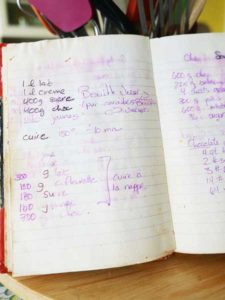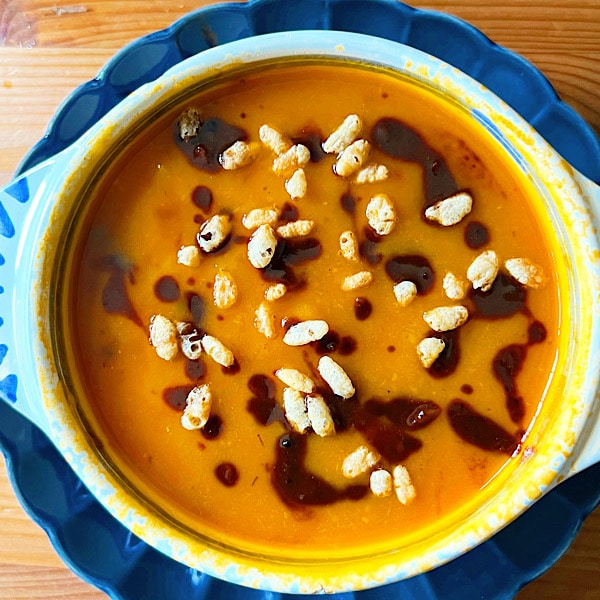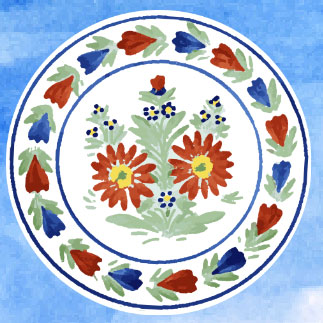 One of the bright spots during an otherwise dark time in my cooking career was working with Marc, a pastry chef from Tours. Marc had been brought into the French bakery/restaurant where I was working in downtown Manhattan so that he could give us assistant pastry chefs a refresher course in the finer points of patisserie. It was an odd arrangement for everyone. The restaurant’s superstar pastry chef was AWOL most of the time (I learned later that he’d had a falling out with the owner and was on his way out) which left Mark—and the rest of us in the pastry kitchen—without any guidance or direction other than the master list of recipes to make each day. Without that guidance, there was no real way for Mark to share his savoir faire with the staff because he spoke very little English. More often than not, he’d just set up in a back corner and go about his business preparing the baked goods and desserts needed for the day.
One of the bright spots during an otherwise dark time in my cooking career was working with Marc, a pastry chef from Tours. Marc had been brought into the French bakery/restaurant where I was working in downtown Manhattan so that he could give us assistant pastry chefs a refresher course in the finer points of patisserie. It was an odd arrangement for everyone. The restaurant’s superstar pastry chef was AWOL most of the time (I learned later that he’d had a falling out with the owner and was on his way out) which left Mark—and the rest of us in the pastry kitchen—without any guidance or direction other than the master list of recipes to make each day. Without that guidance, there was no real way for Mark to share his savoir faire with the staff because he spoke very little English. More often than not, he’d just set up in a back corner and go about his business preparing the baked goods and desserts needed for the day.
Unlike everyone else in that strange, dysfunctional kitchen, Mark was really, genuinely nice. He had no delusions of New York restaurant grandeur, no sense of superiority, no snobbishness. He didn’t need to. He was an amazing pastry chef who could crank out the most beautiful cakes and tarts with grace and incredible speed.
After a couple of days, I started setting up my work station next to his so we could chat and I could learn his techniques. We talked about France (which I missed terribly) and New York (which he was getting to know.) We swapped gossip about our employer (You know he’s declared bankruptcy twice!) and our AWOL head pastry chef. Marc was generous with his knowledge, and his presence made the job bearable for the three or so weeks he was around.
Then one day, Marc was gone—back to France. I never got his last name or the name of the pastry shop where he worked in Tours, so since this all went down before you could just grab a phone and do a quick Google search, so once he was gone, he was gone for good. But thanks to some handwritten instructions for a chocolate custard—“Bouillir” (boil) “verser” (pour) in loopy French script—I can still remember Marc clear as day, even though the rest of my coworkers from that time are a chef’s-jacket-and-clog-wearing blur. (The restaurant owner and the pastry chef remain fairly famous, so unfortunately, I can’t forget THEM.)
I pulled out Marc’s recipe the other day to make dessert for an American friend’s going away party. Amy asked for something chocolate, I wanted it to be something French…but didn’t have time for an elaborate patisserie. Marc’s Chocolate Custard Tart fit the bill perfectly. And really, it was high time I wrote the recipe down elsewhere (here) since Marc’s and my handwritten notes are fading fast!
Marc’s Chocolate Custard Tart
The filling for this tart is pretty close to perfection. It’s thick and creamy, neither too dense nor too runny, and richly chocolate. The sweet crust for my version of Marc’s tart calls for baking powder, which makes it tender and light. I think the texture—more like a soft sugar cookie than your usual sweet crust—goes well with the soft, silky custard, but any pre-baked crust will work here. I’ve given instructions for the tart pan I used, but you could just as easily make smaller pies or even individual tartlets and adjust the baking time accordingly. You could also skip the crust and just use a prepared crust (graham cracker or cookie crust would also work really well here). I’ve also added canned pear halves to the tart at times with spectacular results.
Crust
1 ½ cups (175g) flour
¼ cup (50 g.) sugar
¼ tsp. (1 g.) baking powder
pinch salt
2 oz. (1/2 stick/50 g.) cold butter, cut into pieces
2 eggs, lightly beaten
Filling
¾ cup heavy cream
¾ cup milk
5 oz. (140 g.) bittersweet chocolate, cut into small pieces
½ cup (120 g.) sugar
3 eggs
To make the Crust: Combine the flour, sugar, baking powder, and salt in a medium bowl. Rub the butter pieces into the flour mixture with your fingers until the mixture resembles coarse sand. Make a well in the center of the flour-butter mixture, and add the eggs. Use your fingers or a rubber spatula to mix the eggs into the flour mixture until a smooth dough forms. Pat the dough into a round disk, wrap in plastic wrap, and refrigerate 1 hour, or up to 3 days.
Place an 11-inch fluted tart pan with a removable bottom on a large baking sheet, and brush the bottom and sides with melted butter, or coat with cooking spray.
Roll out the Crust to a 13-inch diameter circle on a well-floured work surface. Transfer the Crust to the prepared tart pan, press it in well to the sides, and trim the excess along the top. Place the Crust in the refrigerator for ½ hour or in the freezer for 15 minutes.
Preheat the oven to 400˚F (200˚C). Fill the tart crust with pie weights or cover with a piece of parchment paper and fill with dried beans, and bake 10 to 15 minutes, or until the crust is golden brown on the edges. Remove the weights or beans, reduce the oven heat to 350˚F (180˚C), and bake 10 to 12 minutes more, or until the crust looks dry and is just beginning to brown on the bottom.
Meanwhile, to make the Filling: Bring the cream and milk to a boil in a medium saucepan, and place the chocolate in a medium bowl. Pour the boiling cream over the chocolate, and whisk to melt the chocolate. Return the mixture to the saucepan, and bring to a boil once more. Boil 1 minute.
Whisk together the eggs and sugar in the bowl used for the chocolate. Whisk about ½ cup of the boiling mixture into the eggs to temper. Gradually whisk in the remaining chocolate mixture.
Pour the chocolate custard into the pre-baked crust, and bake (at 350˚F/180˚C) 15 to 20 minutes, or until the custard begins to bubble around all of the edges. Cool on the baking sheet, then remove from the tart pan. Serve chilled or at room temperature.



Leave A Comment